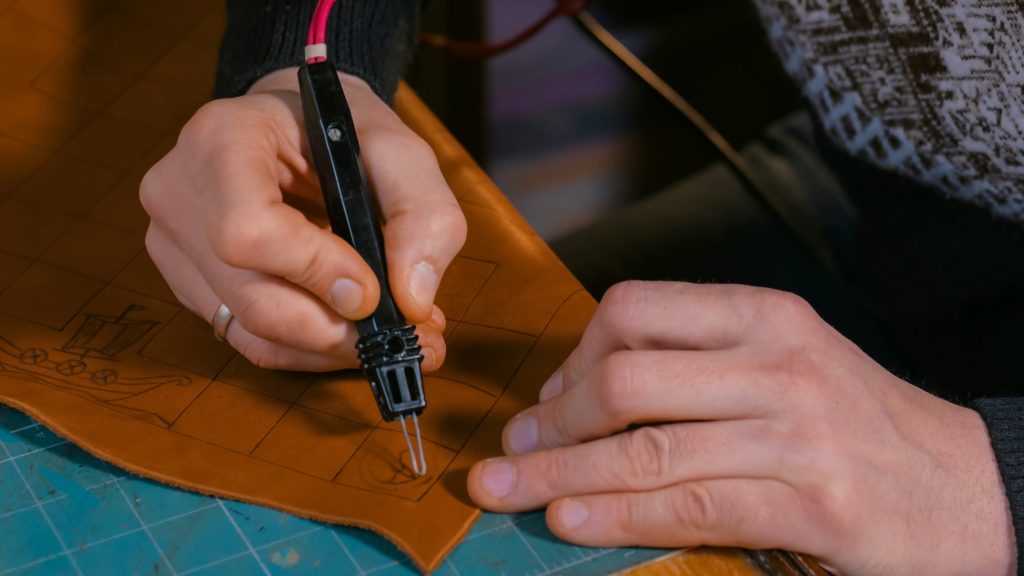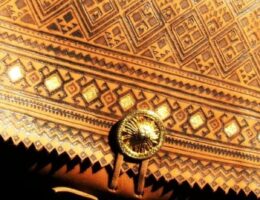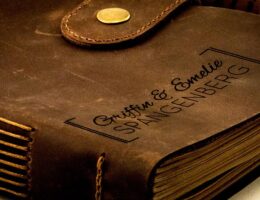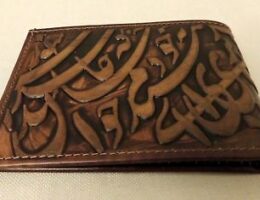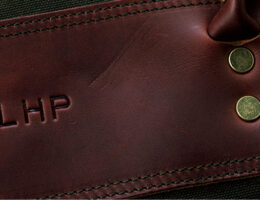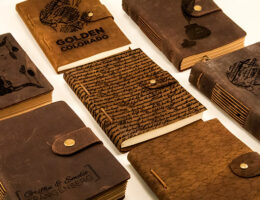IRAN ART EXHIBITION: HOW TO GET STARTED IN LEATHER PYROGRAPHY
Leather is a uniquely versatile material and when combined with the age old technique of picture making and writing, pyrography, it’s always an absolute thrill as to the kind effects you can create. So, what is leather pyrography? Leather pyrography is a leather decorative technique of using a leather scorching tool to burn designs on the grain surface of leather. Leather pyrography is best done on vegetable tanned leather because it’s not chemically tanned and the surface burns beautifully.
Leather pyrography is a remarkable skill set on its own, but is it all there is to know about leather pyrography? Keep reading to find out more.
What is Leather?
Leather surrounds us in almost every aspects of our lives. Talk of art, apparels, transports, home, etc, and you will surely find the use of leather. Leather is a very durable material sourced from the hides and skins of animals.
Leather as a material goes through a process called tanning, which turns it from fresh animals skins into what we see and use as leather. The tanning process turns leather into an imperishable or a material that doesn’t deteriorate, thus, making it one of the most perfect materials for a lot of things we use everyday.
While there are a lot of tanning methods for leather, there are two main types of tanning that’s very common. There’s the vegetable tanned leather and the chrome tanned leather.
But among these two common types of leather, the vegetable tanned leather is the one which is best for leather pyrography.
What is Pyrography?
The term pyrography originally comes from 2 Greek words, “pur” which means fire and “graphos” meaning to write. So when put together, it literally means “writing with fire”. Today, while the use of pyrography as a way of writing still remains, its application is now more of drawing, branding leather works, designing, etc.
Pyrography is the use of burning or scorching tools to etch drawings, writings, or designs on the surface of materials such as wood, leather, gourds, paper, or any other material that wouldn’t get damaged by the dry heat from the burning tool.
From history, we learnt how the prehistoric men also known as the cavemen used charred sticks, to mark and burn wood.
So it’s clear how from the ancient times, the natural material of choice for “pyrography” has been wood but with wood being an organic material that deteriorates with time, a lot of the earliest pyrography work were lost because wood could not survive thousands of years.
But, some studies done has traced the possible origin of pyrography to as far as the Han Dynasty (206BC – 220AD) where it was used as a “Fire Needle Embroidery”.
The practice of pyrography has been reinvented so many times in terms of new tools, materials, and techniques. The great thing about pyrography is it’s transferable and applicable in a lot of crafts and that’s why it’s so popular.
What is Leather Pyrography?
Having a fair idea of what leather is and what pyrography is, it’s a lot easier to phantom what these two terms being married together means. Leather Pyrography is as burning designs or writings primarily on leather with a burning tool.
Leather is a great material to burn on and doing pyrography on leather is very satisfying. Unlike wood, leather has no grains you will need to navigate. The tips or nibs of the heated burning tool will sink nicely into the grain side of the leather and allows you to smoothly burn your impressions.
Doing pyrography on leather is really smooth and fast and the level of smoothness will be hard to achieve with wood due to its grains.
IRAN ART EXHIBITION: Another fantastic thing about leather pyrography is how a lot of tones, shades, and highlights can be effected in a very dramatic way. Leather pyrography’s true aesthetic appeal lies with it’s rustic sepia appearance.
Tools Needed To Get Started In Leather Pyrography
Getting started in Leather pyrography, fortunately, doesn’t require a lot of tools. But while there are only a few tools to get started, it’s however, important to arm yourself with the right set of tools.
A good entry point of leather pyrography for an absolute beginner is to get Pyrography Kit. A pyrography kit doesn’t cost much and will offer a wide range of pens, tips, and a lot auxiliary accessories to get you started. If you decide to take leather pyrography a lot more seriously, you can later invest in the high-end options.
Here are a few tools you need to get started in leather pyrography.
• A leather burning tool
• Leather
• Tracing/Carbon Paper or Stencils
• A Smooth surface
• Stylus/Pencil
1. Leather Burning Tool
The leather burning tool is obviously the most important tool for leather pyrography. The leather burning tool in simple terms is a handheld tool with a handle you can hold on almost like a pen and a burning tip.
The most important things to consider with your burning tools is first, to ensure the handle is made of materials that doesn’t transmit heat easily and secondly, that the tip is appropriate for the type of burn you’re rendering. You can always start with the very common for pyrography!
There’re countless burning nibs and what’s important is what you get used to and comfortable working with.
Finally, another aspect of the leather burning tool is either getting a variable heating tool you can regulate to a high temperature or low temperature heating Or a one temperature heating tool that would only have a single high temperature heating.
It’s better to have a leather burning tool that you can regulate. This is because unlike wood, leather doesn’t require too much heat to burn.
2. Leather
The Leather material is a surface on which pyrography is done, thus, the name leather pyrography. However, not all types of leather are appropriate for pyrography.
As mentioned earlier, the natural vegetable tanned leather is the best type of leather for pyrography. This is because, vegetable tanned leathers are made with no chemicals and it’s surface gives off the true natural rustic leathery appearance characteristic of pyrography.
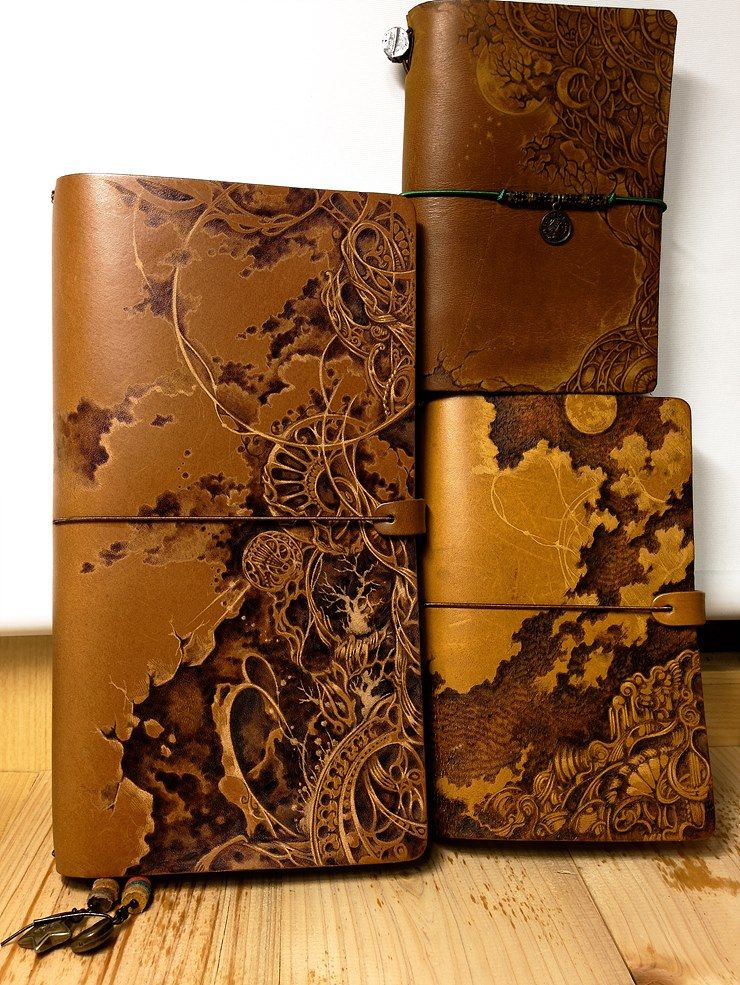
3. Carbon Paper, Stencils, & Tracing papers
The carbon paper is a type of paper that has a loosely bound layer of dry ink that you can use to transfer designs or images. This is what you’re going to be using to put your designs onto the leather.
Another way you can do this is by using s tracing paper on which you would first have your design pre-made and then transferred onto the leather. You can as well, always freehand draw on the leather with a soft pencil if you’re confident enough to do so.
There’s another option of using special metal sheet stencils. These stencils make a lot of difference because it comes hollow cut and you could have unlimited range of patterns, symbols or designs that you could simply burn directly onto the leather.
A very common and easy way of getting your design laid out on your leather is by printing or hand-drawing your design to scale on a paper and then tracing it onto the leather.
4. A Smooth surface
For you to get a nice consistent burn, you will have to get a smooth hard surface to put your leather on before doing your pyrography. When starting out in leather pyrography, you can take a rain check on this one and use your coffee table provided your comfortable and that will work fine as a workbench or table.
IRAN ART EXHIBITION: You can also use a wooden board or cutting mat so that the surface you’re working on will be protected especially if it’s your dinner table of coffee table.
5. Stylus
The stylus will be very useful for transferring designs from paper, tracing paper, or carbon papers. The stylus is a handheld tool that you’d use like a pen but only styluses are blunt.
Conclusion
This article was a brief introduction into the world of leather pyrography and hope you found this post helpful in making have a general idea about what leather pyrography is, the tools and materials needed to get started and a couple more things in between! Cheers!
